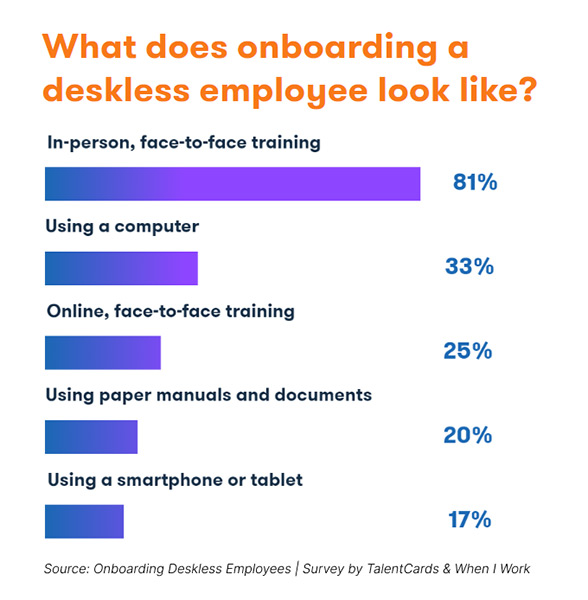While optimizing the production line and tech gets a lot of attention, there’s also money to be saved in optimizing employee training.
Whether your company is bracing for a recession, or ramping up production to meet demand, it’s always the right time to cut down on unnecessary costs. For a significant number of manufacturing companies, those unnecessary costs are hiding in their training and development budget.
By no means is this a suggestion that companies should cut down on employee training and development. Instead, it’s a call to do it better and more efficiently. And the solution to doing so is leveraging the power of mobile training software.
Mobile training software is software that delivers training content to people via a mobile device – smartphones and tablets. What may come as a surprise, though, is that a recent report by TalentCards revealed that only 17% of companies in manufacturing, construction, shipping, transportation, and energy are using mobile devices to train newly hired employees:

While it is to be expected that in-person, face-to-face training is the most common way to deliver training to frontline employees, it’s surprising that paper manuals still exceed the use of smartphones and tablets.
For manufacturing companies, delivering training on a mobile device is a game-changer. Using mobile training software empowers your employees to:
In addition to all of these benefits, mobile training software saves your company money. Here’s how:
At first glance it may not seem like much, but think about how much money gets spent on printing hundred page manuals for every new hire in your company. According to a TalentCards survey of onboarding managers in the manufacturing industry, at least 20% of companies train new hires using paper manuals and documents.
There are multiple reasons why this is an inefficient training method:
First, if you need to make any edits or additions to your training manual, then you need to pay for all new copies to be printed.
Second, it’s highly unlikely that after you’ve onboarded a new hire they’re carrying that manual around with them on the job (even if they’re supposed to).
And finally, when an employee leaves the company (36% of new hires in manufacturing quit within the first 12 months) it’s unlikely that you’ll get that manual back.
By switching to mobile training you completely eliminate the cost that comes with making edits and updates to your training materials, you make it easy for employees to have their content on hand, and you haven’t lost a copy of that content every time someone leaves the company.
Let’s say you’re not using paper manuals, and instead you’ve moved your training online for people to complete using a laptop. While this eliminates the cost of printing new manuals and workbooks, it creates two new expenses:
Mobile training software takes care of both of these problems. You don’t have to provide laptops since employees would use their smartphones to complete training. (When surveyed, 74% of deskless employees said they feel comfortable using their own mobile devices to complete training).
And mobile access to training means employees can reference their materials right on the job, the moment they need them. Having this kind of access doesn’t just improve productivity— it also creates a more impactful learning experience. Employees can apply the new skills they’re being taught in real time, instead of first learning in a classroom setting, and then moving to the real environment.
Forty-one percent of manufacturing companies have experienced some type of accidents as a result of an employee being improperly trained.
The reality is that these types of accidents have a tendency to be entirely preventable. One of the best ways to successfully prevent them is through reinforcement training.
By encouraging and prompting employees to practice and review their safety training and procedures on a regular basis, you’ll reduce the likelihood of an accident occurring. In fact, 80% of deskless employees said that they prefer shorter, more frequent training sessions over longer, one time events.
Mobile training software gives you the ability to set up regular review reminders for employees, and send out quick quizzes and knowledge checks. These help you identify problem areas in your teams’ knowledge, and correct them before they cause issues.
While you can’t calculate the exact amount of money that your company will save from preventing an accident, you can’t underestimate it.
Top-down changes that propel a company forward are ones that simultaneously lower cost, and increase output. Introducing mobile training software to your company has the power to be one of those changes. By empowering employees to train from anywhere, while cutting unnecessary costs, you’ll give your business room to grow both in terms of budget, and talent.
About the author
Leonidas Palaiokostas
Product Owner, TalentCards
Leonidas is the Product Owner of TalentCards, a mobile training app created by learning technology company, Epignosis. Leading the TalentCards team even before its 2018 launch, he has built the platform and the team behind it from the ground up. Leonidas has over a decade of experience as a software engineer in SaaS companies.
In this episode, I sat down with Beejan Giga, Director | Partner and Caleb Emerson, Senior Results Manager at Carpedia International. We discussed the insights behind their recent Industry Today article, “Thinking Three Moves Ahead” and together we explored how manufacturers can plan more strategically, align with their suppliers, and build the operational discipline needed to support intentional, sustainable growth. It was a conversation packed with practical perspectives on navigating a fast-changing industry landscape.